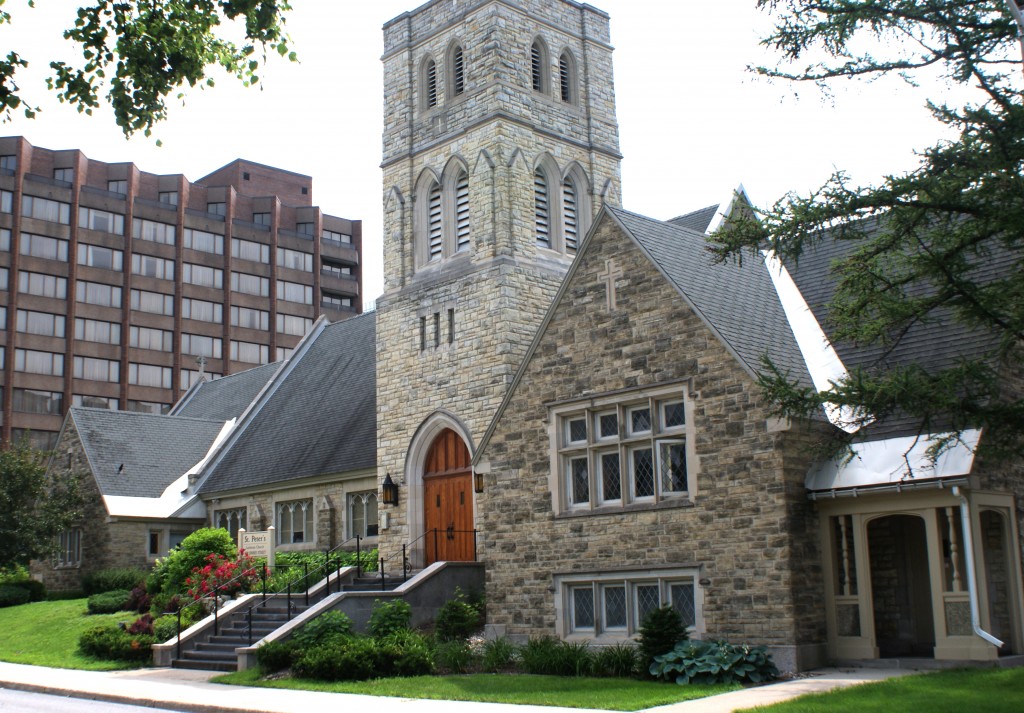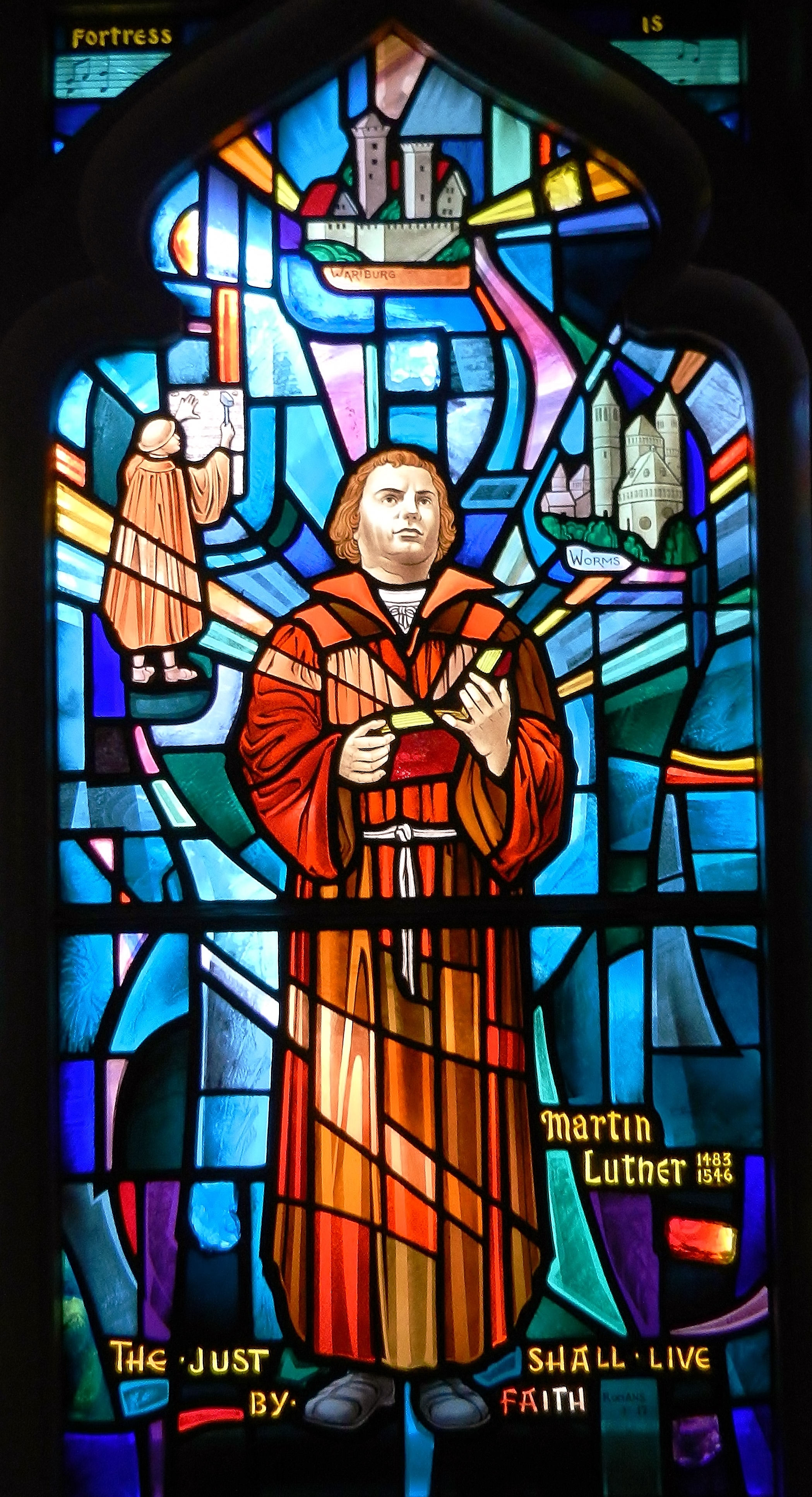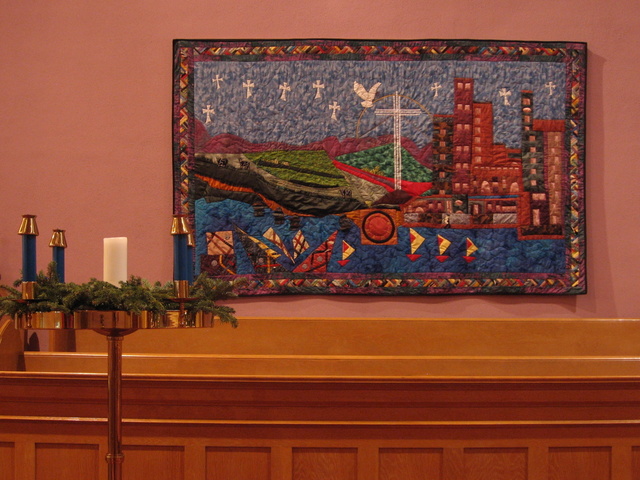St. Peter’s Church Building
St. Peter’s Lutheran Church, Ottawa, is an architectural landmark located in the heart of Canada’s national capital. Dedicated in 1954, the building was designed in English Gothic style by the prominent architect Cecil Burgess (1888-1956). Born and educated in England, Burgess practiced in Ottawa for nearly fifty years. His longstanding interest in the architectural principles of the Gothic Revival, which culminated in St. Peter’s, is already evident in 1920s, in designs such as St. Andrew’s Presbyterian Church (Perth, Ontario), and St. Matthew’s Anglican Church (Ottawa). St. Peter’s is a project of his mature years, designed with graceful proportions, built with fine materials and finished with a craftsman’s attention to detail. The exterior is faced with sandstone similar to the stone used for buildings in the Parliamentary precinct. The interior displays fine examples of wood carving on the altar, reredos, pulpit, lectern and font. At the time of building, the height of St. Peter’s tower was reduced from the original plans due to lack of funds. The tower was extended in 1968 under the direction of architect Oskars Krause.
Stained Glass
St. Peter’s stained glass is a cycle of nine narrative windows focused on the life of Christ and the Lutheran heritage. The windows were designed and executed by Canadian artist Russell Goodman and his studio between 1985 and 1993. The artist received an Order of Canada in 1989 and a Governor General’s Award in Visual and Media Arts in 2001. His work is known for vibrant combinations of colours. Notable previous commissions include windows in the House of Commons Chamber of the Canadian Parliament.
St. Peter’s Chancel Window is rich in symbols portraying Word and Sacrament. A figure of the risen Christ faces the congregation with outstretched arms. Prominent Ottawa landmarks are displayed at his feet: the National Library and Archives, Parliament Buildings and Peace Tower, and Supreme Court of Canada.
The central panel of the Music Window features Martin Luther (1483-1546), celebrated as a founder of the Reformation and framed by vignettes representing decisive moments in Reformation history. In the left and right panels, Luther is accompanied by George Frideric Handel (1685-1759) and Johann Sebastian Bach (1685-1750).
The History Window depicts excerpts from Canadian Lutheran history and symbols of the Canadian landscape. Central figures are Adam Keffer (1808-1876), a dedicated lay person, the Rev. Herman Hayunga (1799-1872), a preacher in Upper Canada, and the Rev. Charles Cossman (1806-1897), who founded congregations in the Maritimes.
Six windows focus on the life of Christ. The Epiphany Window narrates events from his early life that reveal his divinity. The Discipleship Window illustrates the call to follow in ministry. The Teaching Window refers to his great commandment, ”Love one another” (John 15:17). The Children’s Window depicts him accompanied by an allegorical figure of motherhood, St. Nicholas as a Bishop of the Church, and figures representing children of the world. The Passion Window captures events leading to his death. The Resurrection Window depicts events in the Easter narrative.
Altar Cross
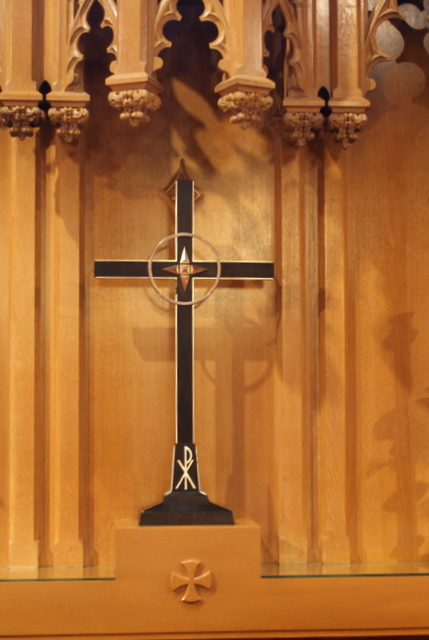 The ebony and silver altar cross was created by Swedish artist Sven Arne Gillgren (1913-1992), whose work is represented in the collections of the National Museum in Stockholm. The cross was a gift from Sweden in 1954. It displays a symbolic message of hope and resurrection based on the life of Christ. At the intersection of the arms, a four-pointed star of Bethlehem is enclosed in a circle. The star refers to Jesus’s Nativity; the circle is a traditional symbol of eternity, without beginning or end. At the base of the cross, the Christogram Chi (X) – Rho (P) is an ancient symbol composed from the first two letters of the Greek word for Christ.
The ebony and silver altar cross was created by Swedish artist Sven Arne Gillgren (1913-1992), whose work is represented in the collections of the National Museum in Stockholm. The cross was a gift from Sweden in 1954. It displays a symbolic message of hope and resurrection based on the life of Christ. At the intersection of the arms, a four-pointed star of Bethlehem is enclosed in a circle. The star refers to Jesus’s Nativity; the circle is a traditional symbol of eternity, without beginning or end. At the base of the cross, the Christogram Chi (X) – Rho (P) is an ancient symbol composed from the first two letters of the Greek word for Christ.
Baptismal Font
In 1998 St. Peter’s baptismal font was refurbished by Quebec artist Jacques Bradet. The artist retained the carved wooden base from the original font and created a new raised bowl and fitted lid. Contemporary in design, the bowl and lid are formed from hammered brass and detailed to echo the Gothic decoration of the base.
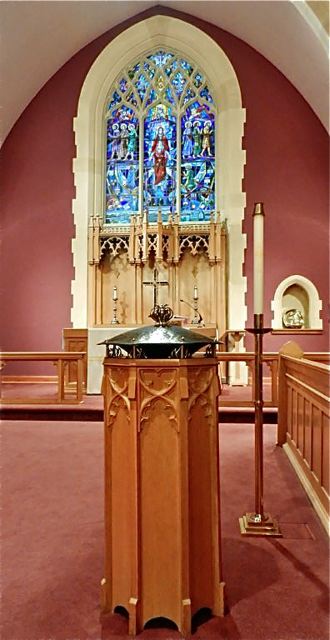
Wall Hangings
The use of wall hangings in churches has a long history that looks back to celebrated examples such as the 14th century Apocalypse Tapestry in Angers, France and the 16th century Vatican tapestries designed by Raphael for the Sistine Chapel. In keeping with the traditions of Christian art, St. Peter’s commissioned three fabric wall hangings from Quebec artists Francine and Gary Slippert. “Noël” (1994) and “Resurrection” (1997) celebrate the liturgical festivals of Christmas and Easter. “Community in Christ” (2000) is a spiritual landscape inspired by the view from St. Peter’s toward the Ottawa River and Gatineau Hills.
Crèche
During 2003, St. Peter’s Lutheran Church commissioned André Pelletier, a noted Canadian sculptor in Saint-Jean-Port-Joli, Quebec, to design and carve a crèche for St. Peter’s chancel. The crèche is intended to enrich the Advent, Christmas and Epiphany seasons at St. Peter’s and provide a teaching focus, particularly for children. A scale of 18 inches was selected for the figures, so the completed crèche might be displayed in its entirety or in smaller parts, reflecting the narrative of the nativity story.
André Pelletier, who studied drawing and wood sculpture at the school of Jean Julien Bourgault, has been practicing his art since 1960. He has created a number of crèches, now in France and the United States. The traditional Christmas crèche for St. Peter’s Church is a beautiful work of art in bass wood.
The crèche was dedicated Christmas Eve, 2003, and the magi were blessed on Epiphany, 2004. Two additional shepherds arrived early in 2004; a shepherd boy and additional sheep were added in 2006.
